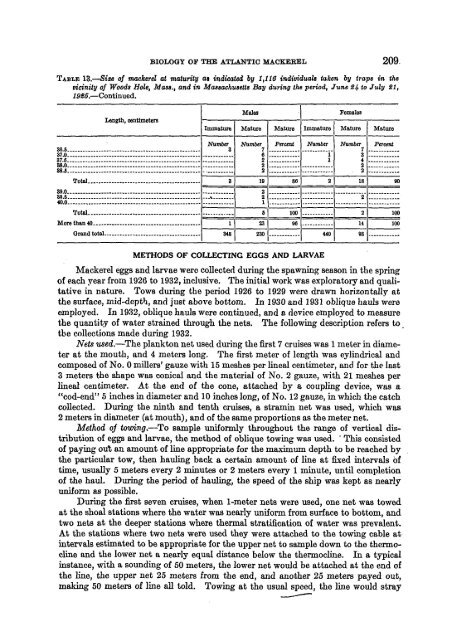Fishery bulletin of the Fish and Wildlife Service - NOAA
Fishery bulletin of the Fish and Wildlife Service - NOAA
Fishery bulletin of the Fish and Wildlife Service - NOAA
Create successful ePaper yourself
Turn your PDF publications into a flip-book with our unique Google optimized e-Paper software.
BIOLOGY OF THE ATLANTIC MACKEREL 209<br />
TABLE 13.—Size <strong>of</strong> mackerel at maturity a» indicated by 1,116 individuals taken by traps in <strong>the</strong><br />
vicinity <strong>of</strong> Woods Hole, Mass., <strong>and</strong> in Massachusetts Bay during <strong>the</strong> period, June 24 to July SI,<br />
1986.—Continued.<br />
36.5<br />
37.0<br />
37.6<br />
88.0 - - -<br />
88.Я<br />
39.0<br />
S9.5<br />
40.0<br />
Total<br />
Total<br />
More than 40 + -. ... ... . *. .. .<br />
Gr<strong>and</strong> total. ,<br />
Immature<br />
Number 3<br />
3<br />
1<br />
348<br />
Males<br />
Mature<br />
Number 76222<br />
19<br />
2<br />
2 1<br />
S<br />
23<br />
230<br />
Mature<br />
Percent<br />
86<br />
100<br />
96<br />
Immature<br />
Number<br />
1<br />
METHODS OF COLLECTING EGGS AND LARVAE<br />
2<br />
440<br />
Females<br />
Mature<br />
Number 73422<br />
18<br />
2<br />
2<br />
14<br />
98<br />
Mature<br />
Percent<br />
Mackerel eggs <strong>and</strong> larvae were collected during <strong>the</strong> spawning season in <strong>the</strong> spring<br />
<strong>of</strong> each year from 1926 to 1932, inclusive. The initial work was exploratory <strong>and</strong> qualitative<br />
in nature. Tows during <strong>the</strong> period 1926 to 1929 were drawn horizontally at<br />
<strong>the</strong> surface, mid-depth, <strong>and</strong> just above bottom. In 1930 <strong>and</strong> 1931 oblique hauls were<br />
employed. In 1932, oblique hauls were continued, <strong>and</strong> a device employed to measure<br />
<strong>the</strong> quantity <strong>of</strong> water strained through <strong>the</strong> nets. The following description refers to<br />
tbe collections made during 1932.<br />
Nets used.—The plankton net used during <strong>the</strong> first 7 cruises was 1 meter in diameter<br />
at <strong>the</strong> mouth, <strong>and</strong> 4 meters long. The first meter <strong>of</strong> length was cylindrical <strong>and</strong><br />
composed <strong>of</strong> No. 0 millers' gauze with 15 meshes per lineal centimeter, <strong>and</strong> for <strong>the</strong> last<br />
3 meters <strong>the</strong> shape was conical <strong>and</strong> <strong>the</strong> material <strong>of</strong> No. 2 gauze, with 21 meshes per<br />
lineal centimeter. At <strong>the</strong> end <strong>of</strong> <strong>the</strong> cone, attached by a coupling device, was a<br />
"cod-end" 5 inches in diameter <strong>and</strong> 10 inches long, <strong>of</strong> No. 12 gauze, in which <strong>the</strong> catch<br />
collected. During <strong>the</strong> ninth <strong>and</strong> tenth cruises, a stramin net was used, which was<br />
2 meters in diameter (at mouth), <strong>and</strong> <strong>of</strong> <strong>the</strong> same proportions as <strong>the</strong> meter net.<br />
Method oj towing,—To sample uniformly throughout <strong>the</strong> range <strong>of</strong> vertical distribution,<br />
<strong>of</strong> eggs <strong>and</strong> larvae, <strong>the</strong> method <strong>of</strong> oblique towing was used. ' This consisted<br />
<strong>of</strong> paying out an amount <strong>of</strong> line appropriate for <strong>the</strong> maximum depth to be reached by<br />
<strong>the</strong> particular tow, <strong>the</strong>n hauling back a certain amount <strong>of</strong> line at fixed intervals <strong>of</strong><br />
time, usually 5 meters every 2 minutes or 2 meters every 1 minute, until completion<br />
<strong>of</strong> <strong>the</strong> haul. During <strong>the</strong> period <strong>of</strong> hauling, <strong>the</strong> speed <strong>of</strong> <strong>the</strong> ship was kept as nearly<br />
uniform as possible.<br />
During <strong>the</strong> first seven cruises, when 1-meter nets were used, one net was towed<br />
at <strong>the</strong> shoal stations where <strong>the</strong> water was nearly uniform from surface to bottom, <strong>and</strong><br />
two nets at <strong>the</strong> deeper stations where <strong>the</strong>rmal stratification <strong>of</strong> water was prevalent.<br />
At <strong>the</strong> stations where two nets were used <strong>the</strong>y were attached to <strong>the</strong> towing cable at<br />
intervals estimated to be appropriate for <strong>the</strong> upper net to sample down to <strong>the</strong> <strong>the</strong>rmocline<br />
<strong>and</strong> <strong>the</strong> lower net a nearly equal distance below <strong>the</strong> <strong>the</strong>rmocline. In a typical<br />
instance, with a sounding <strong>of</strong> 50 meters, <strong>the</strong> lower net would be attached at <strong>the</strong> end <strong>of</strong><br />
<strong>the</strong> Line, <strong>the</strong> upper net 25 meters from <strong>the</strong> end, <strong>and</strong> ano<strong>the</strong>r 25 meters payed out,<br />
making 50 meters <strong>of</strong> line all told. Towing at <strong>the</strong> usual speed, <strong>the</strong> line would stray<br />
90<br />
100<br />
100

















